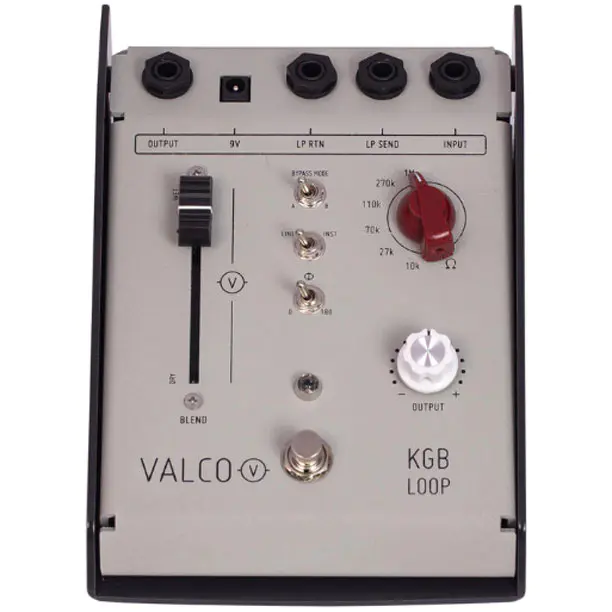
The Valco FX KGB Loop is a utility pedal built for guitar, bass, and synthesizer/keyboards featuring an FX Loop with blendable controls, a boost, and a Variable Input Impedance that can also be used for sculpting purposes, just like in the other pedals in the KGB line.
The peculiarity of this pedal consists in how it interacts with other devices, with the Impedance knobs (only active in “Inst” mode) acting as some sort of tone control, making your sound warmer at lower settings and brighter and more in your face at higher settings.
The FX Loop is linked to the Blend fader, which allows the mixing of the dry signal (as it’s fed to the external pedal) and the return signal from the external pedal(s). A phase switch can help overcome phase issues related to mixing two similar and slightly delayed signals.
Next in line, the Boost knob can push the resulting signal up to 24db of gain, which is more than enough to push your amp to the edge of breakup (and beyond).
Check out the first video of the Valco FX KGB Loop!
Valco FX KGB Loop/bn
The KGB Loop is the ‘Swiss Army Knife’ pedal that lets you add Valco’s unique input impedance control, line input capability, and wet/dry blend fader to any effect pedal of your choice.
The external pedal’s input is connected to the KGB Loop’s “LP SEND” jack and its output to the “LP RTN” jack.
The KGB Series is designed specifically to work with K (keys, synths), G (guitar), and B (bass). The Variable Input Impedance works best with passive instruments (guitar / bass) and allows tone-sculpting with or without the LOOP circuit engaged.
The footswitch provides a true bypass function that offers two operating modes, controlled by the “Bypass Mode” switch.
In Mode A, the footswitch alternates between full bypass and the complete KGB Loop signal chain in including an external pedal. In this mode, please ensure the external pedal is switched on.
This allows the complete bypass of the KGB Loop and the external pedal with just the KGB Loop’s switch. This is great for use with older ‘tone suck’ pedals (older Fuzz Faces, early Big Muff’s, etc).
In Mode B, the footswitch alternates between the external pedal alone and the external pedal with KGB Loop features added around it.
This allows the external pedal to be fully used as normal.
To achieve full bypass in Mode B, the external pedal’s on/off footswitch must be used.
The KGB Loop’s input includes a switch to select between instrument and line input levels, and a rotary selector that provides six possible input impedances ranging from 10 kilohms to 1 Megohm.
MORE DETAILS
The impedance selector can be used to explore tonal possibilities by changing the impedance match to the guitar or bass’s pickups. The impedance selector is only effective when the input selector is in the “INST” position. When the “LINE” position is selected, the input impedance is 10 kilohms and the signal level is attenuated to be compatible with up to 4 dBu line input levels, suitable for use with keyboards and other line level devices.
The input signal is unity gain buffered by a low-noise audio-grade OPA1692 op amp that feeds the external pedal input through the “LP SEND” jack and the dry input to the crossfader. The “LP SEND” signal is essentially a buffered dry output.
The phase inversion switch controls a phase inversion circuit at the “LP RTN” input. This function is especially useful with delay, phase shift and distortion pedals. The phase inversion switch does not affect the dry signal to the fader and LP SEND jack.
The blend slider implements a sigmoid curve cross fader between the dry signal (as fed to the external pedal) and the (optionally phase inverted) return signal from the external pedal. The fader is based on a dual channel CMOS variable attenuator.
The blended output is amplified by a second low-noise OPA1692 audio op amp to provide variable post-fader gain of between-12 and +16 dB, controlled by the logarithmic tape “OUTPUT” potentiometer.
The KGB Loop can be powered by a conventional 9V center-negative external supply, or an internal 9V battery, accessible by rotating the quarter turn latch at the bottom front of the pedal and rotating the top panel away from the bottom.
MAIN FEATURES
• Variable input-impedance selection, stepped from 10k to 1M
• Boost/Attenuation (from -6dB to +24dB)
• Blend dist/dry mix fader
• Polarity Reverse Switch 0/180- reverses the Dry audio signal polarity to be used in conjunction with the BLEND function. 180 setting allows for some frequency cancellation between the DRY and LOOP signals, and is used for alternative/varying Blended tones.
• Phase Reversal (0/180 phase reverse of the FX loop circuit for increased tonal options)
• Line/Inst level selector (use with line level signals (synths, mixer aux sends, etc) or instrument levels (guitar, bass))
• Dual bypass modes (A and B)






















